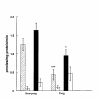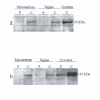Important differences in nitric oxide synthase activity and predominant isoform in reproductive tissues from human and rat
- PMID: 12657160
- PMCID: PMC152645
- DOI: 10.1186/1477-7827-1-10
Important differences in nitric oxide synthase activity and predominant isoform in reproductive tissues from human and rat
Abstract
For the extrapolation of data obtained from experimental animals to the human situation, it is important to know the similarities and differences between human and animal species. Some important characteristics of nitric oxide synthase (NOS) in myometrium and vagina from human and rat were compared. NOS-activity was measured by the formation of 14C-citrulline from 14C-arginine and the expression of NOS isoforms was examined by Western blotting. NOS activity in human uterus and vagina was significantly lower than in the tissues from rat. In contrast to the rat where NOS activity was predominantly found in the cytosolic fractions, NOS activity in particulate and cytosolic fractions from both human myometrium and vagina was similar. Data from Western blots confirmed that eNOS and nNOS isoforms were concentrated in the particulate and cytosolic fractions, respectively. Estrogen treatment of rats resulted in a down regulation of uterine cytosolic NOS activity. A down regulation of NOS in the cytosolic fraction was also seen in the human pregnant myometrium as compared with the nonpregnant myometrium. The vaginal NOS activity was considerably higher than the uterus in both species. In spite of some clear-cut qualitative and other differences between human and rat tissues, there are some interesting similarities. Downregulation in pregnancy of human uterine NOS is probably due to, at least in part, the influence of estrogen and progesterone.
Figures





References
-
- Chwalisz K, Buhimschi I, Garfield GE. Role of nitric oxide in obstetrics. Neonatal medicine. 1996;14:293–328.
-
- Sladek SM, Magness RR, Conrad KP. Nitric oxide and pregnancy. Am J Physiol. 1997;272:R441–R463. - PubMed
-
- Buhimschi I, Valentin C, Chwalisz K, Garfield RE. Pre-eclampsia-like conditions produced by nitric oxide inhibition: effects of L-arginine, D-arginine and steroid hormones. Hum Reprod. 1995;10:2723–2730. - PubMed
-
- Yallampalli C, Buhimschi I, Chwalisz K, Garfield RE, Dong YL. Preterm birth in rats produced by the synergistic action of a nitric oxide inhibitor (NG-nitro-L-arginine methyl ester) and an antiprogestin (onapristone). Am J Obstet Gynecol. 1996;175:207–212. - PubMed
-
- Sladek SM, Regenstein AC, Lykins D, Roberts JM. Nitric oxide synthase activity in pregnant rabbit uterus decreases on the last day of pregnancy. Am J Obstet Gynecol. 1993;169:1285–1291. - PubMed
Publication types
MeSH terms
Substances
LinkOut - more resources
Full Text Sources

